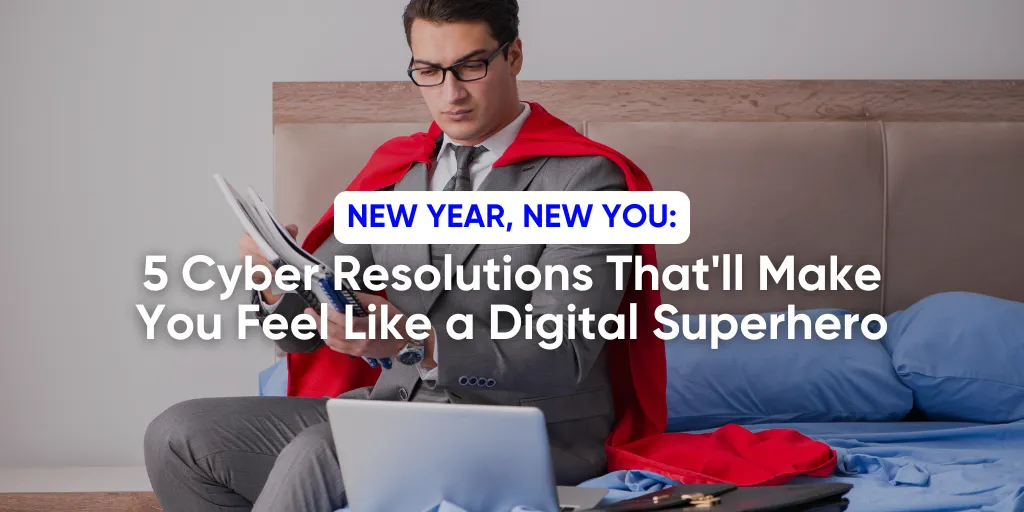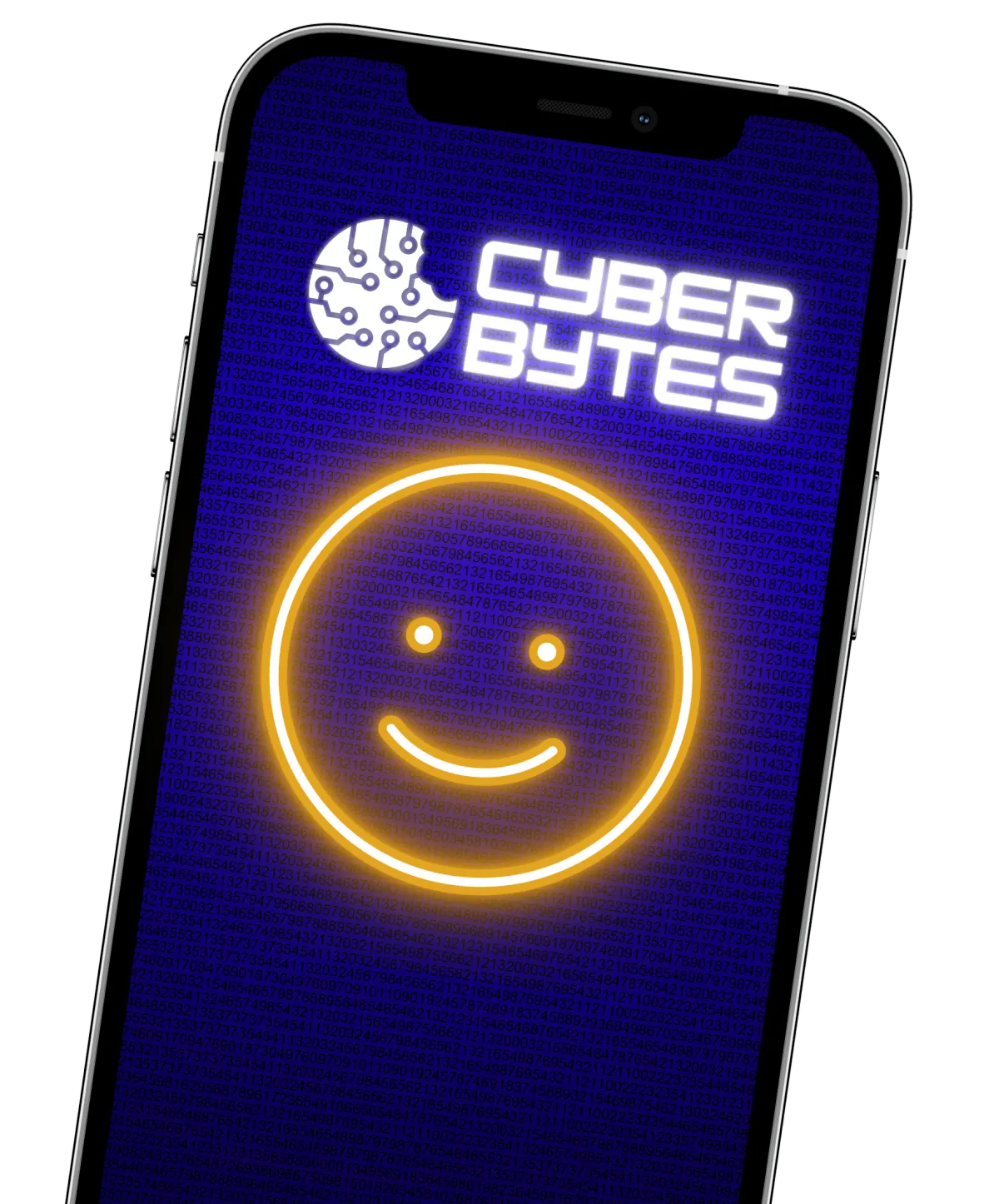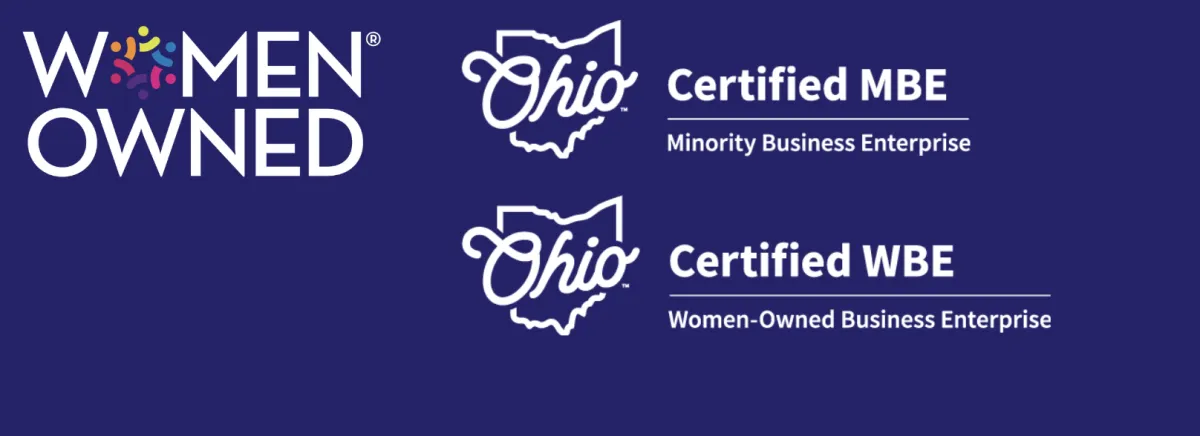You are what you click!
Learn how to make cybersecurity your way of life in an easy and guided way.
You are what you click!
Become Cyber savvy
EXPLORE BLOG BELOW
You are what you click!
Become Cyber savvy
You are what you click!
Become Cyber savvy
You are what you click!
Become Cyber savvy

New Year, New You: 5 Cyber Resolutions That'll Make You Feel Like a Digital Superhero
As the confetti settles and the champagne glasses are cleared away, a familiar ritual begins: the setting of New Year's resolutions. But while gym memberships surge and diet plans are hastily drafted, there's an often-overlooked aspect of our lives that deserves just as much attention – our digital well-being. In an age where our online presence is as significant as our physical one, it's high time we extended our self-improvement efforts to the virtual realm.
Welcome to your guide for becoming a digital superhero in the coming year. These five cyber resolutions are not just about protecting your data; they're about empowering you to take control of your online life, fostering healthier digital habits, and yes, feeling like you've donned a virtual cape in the process. So, let's embark on this journey to transform your digital self, one resolution at a time.
Resolution #1: The Password Makeover Challenge
Let's face it: your passwords are probably not as robust as you think they are. In fact, according to a recent study by the National Cyber Security Centre, 23.2 million victim accounts worldwide used '123456' as their password. If this makes you squirm uncomfortably, you're not alone – and you're ready for the Password Makeover Challenge.
This resolution isn't just about changing your passwords; it's about revolutionizing your approach to digital access. Start by auditing your current passwords. Are they unique for each account? Do they include a mix of uppercase and lowercase letters, numbers, and symbols? If not, it's time for an overhaul.
Consider adopting a password manager – a digital vault that not only stores your passwords securely but can also generate complex, unique passwords for each of your accounts. Tools like LastPass, 1Password, or Dashlane can be game-changers in your digital security arsenal.
But don't stop there. Take it a step further by implementing a regular password change schedule. Mark your calendar for quarterly password updates, treating it like a digital spring cleaning. This habit not only keeps your accounts safer but also gives you a sense of active participation in your online security.
Remember, a strong password is your first line of defense in the digital world. By taking on this challenge, you're not just changing a few letters and numbers – you're fortifying the gates to your personal digital kingdom.
Resolution #2: The 'Unfollow & Unfriend' Cleanse
Social media, while a powerful tool for connection, can often become a source of digital clutter and emotional drain. This year, resolve to perform the 'Unfollow & Unfriend' Cleanse – a deliberate, mindful pruning of your digital social circles.
This resolution goes beyond mere decluttering; it's about curating a digital environment that nurtures your well-being. Start by assessing your social media feeds. Which connections genuinely add value to your life? Which ones consistently spark joy, inspiration, or meaningful interaction? Conversely, which accounts leave you feeling drained, anxious, or simply indifferent?
Be ruthless in your evaluation. Unfollow accounts that no longer align with your interests or values. Unfriend connections that have grown stale or negative. This isn't about being unkind; it's about creating a digital space that reflects and supports your current life and aspirations.
Consider implementing a '30-day rule': If you haven't meaningfully interacted with a connection in 30 days, consider whether they still deserve a place in your digital life. This ongoing process ensures your social media remains a reflection of your current self, not a museum of past connections.
Remember, your attention is a precious resource. By curating your digital social circle, you're not just tidying up your feeds – you're reclaiming control over your online experience and, by extension, your mental well-being.

Resolution #3: Two-Factor Authentication Transformation
In the realm of cybersecurity, two-factor authentication (2FA) is akin to adding a moat to your digital castle. Yet, despite its effectiveness, many users still haven't embraced this powerful security measure. This year, resolve to implement 2FA across all your important accounts – a transformation that will significantly bolster your online defenses.
Two-factor authentication adds an extra layer of security by requiring a second form of identification beyond your password. This could be a code sent to your phone, a biometric scan, or a physical security key. The beauty of 2FA lies in its simplicity and effectiveness – even if a malicious actor somehow obtains your password, they still can't access your account without the second factor.
Start by identifying your most crucial accounts – email, banking, social media, and any platforms containing sensitive personal or financial information. Most major services now offer 2FA options; take the time to explore and activate these features. While it might seem like a hassle at first, the added security far outweighs the minor inconvenience.
For an even more robust approach, consider investing in a hardware security key like YubiKey. These physical devices serve as your second factor, providing an unparalleled level of security for your most critical accounts.
By embracing the Two-Factor Authentication Transformation, you're not just adding an extra step to your login process – you're dramatically reducing the risk of unauthorized access to your digital life. It's a small action that yields significant peace of mind.
Resolution #4: The Mindful Clicking Method
In our fast-paced digital world, the act of clicking has become almost reflexive. We click on links, accept cookies, and download files often without a second thought. This year, resolve to adopt the Mindful Clicking Method – a practice of bringing awareness and intention to your online interactions.
This resolution is about cultivating a habit of pausing before engaging with online content. Before clicking on a link, ask yourself: Do I know where this leads? Is this from a trusted source? When faced with a download, question: Is this file necessary? Am I confident in its safety?
Implement a personal rule of examining URLs before clicking. Look for subtle misspellings or unusual domain extensions that might indicate a phishing attempt. When receiving emails with links or attachments, even from known contacts, take a moment to verify their authenticity, especially if the message seems out of character or urgent.
Extend this mindfulness to your app permissions and cookie acceptances. Regularly review the permissions you've granted to applications on your devices. Do they all need access to your location, camera, or microphone? For cookies, resist the urge to automatically click "Accept All." Take the time to review and adjust your preferences, balancing convenience with privacy.
The Mindful Clicking Method isn't about paranoia; it's about developing a healthy skepticism and awareness in your digital interactions. By cultivating this habit, you're not just protecting yourself from potential threats – you're becoming an active, engaged participant in your online experiences.

Resolution #5: Weekly 'Digital Detox' Ritual
In our hyper-connected world, the concept of 'unplugging' can seem almost radical. Yet, regular digital detoxes are crucial for maintaining both mental well-being and a healthy relationship with technology. This year, commit to a Weekly 'Digital Detox' Ritual – a dedicated time to disconnect from the digital world and reconnect with yourself and your physical environment.
Choose a specific day or time each week for your digital detox. It could be a full day on the weekend or a few hours each evening. During this time, power down non-essential devices. Put your smartphone in a drawer, turn off notifications, and step away from screens. The goal is to create a space free from digital distractions.
Use this time to engage in activities that nourish your offline self. Read a physical book, practice meditation, enjoy nature, or engage in face-to-face conversations with friends and family. The key is to be present in the physical world, free from the constant pull of digital notifications and updates.
This ritual isn't just about avoiding technology; it's about actively cultivating alternative sources of engagement and fulfillment. Keep a journal of your digital detox experiences. Note how you feel before, during, and after these periods of disconnection. You may be surprised by the insights and benefits that emerge.
Over time, you might find yourself looking forward to these digital-free periods, seeing them not as a deprivation but as a gift to yourself. The Weekly 'Digital Detox' Ritual is more than just a break from screens – it's a powerful way to reset your relationship with technology, enhance your mindfulness, and maintain a balanced digital lifestyle.
Conclusion: One Small Action a Day Keeps the Cybermonsters Away
As we wrap up our journey through these five cyber resolutions, remember that becoming a digital superhero isn't about dramatic, overnight transformations. It's about consistent, mindful actions that, over time, build into robust habits and a stronger, more secure digital presence.
The mantra "One small action a day keeps the Cybermonsters away" encapsulates the essence of these resolutions. Each day, choose one small step towards your digital well-being. Maybe it's updating a password, unfollowing a negative account, or taking a short digital break. These individual actions might seem insignificant in the moment, but they accumulate into a powerful defense against the myriad of digital threats and stresses we face.
Moreover, these resolutions aren't just about security – they're about empowerment. By taking control of your digital life, you're not just protecting yourself; you're enhancing your overall quality of life. You're cultivating a healthier relationship with technology, one that serves you rather than controls you.
As you embark on this journey, be patient with yourself. Change takes time, and setbacks are normal. The goal is progress, not perfection. Celebrate your successes, learn from your missteps, and keep moving forward.
Remember, in the vast and sometimes daunting digital landscape, you have the power to shape your experience. With these resolutions as your guide, you're well on your way to becoming the digital superhero you've always had the potential to be. Here's to a safer, more mindful, and empowered digital you in the year ahead!
Live Happily Ever Cyber!

Sandra Estok
Subscribe for more ways to protect what matters most to you against hackers, scammers, and Cybermonsters™
Latest blog posts:

New Year, New You: 5 Cyber Resolutions That'll Make You Feel Like a Digital Superhero
As the confetti settles and the champagne glasses are cleared away, a familiar ritual begins: the setting of New Year's resolutions. But while gym memberships surge and diet plans are hastily drafted, there's an often-overlooked aspect of our lives that deserves just as much attention – our digital well-being. In an age where our online presence is as significant as our physical one, it's high time we extended our self-improvement efforts to the virtual realm.
Welcome to your guide for becoming a digital superhero in the coming year. These five cyber resolutions are not just about protecting your data; they're about empowering you to take control of your online life, fostering healthier digital habits, and yes, feeling like you've donned a virtual cape in the process. So, let's embark on this journey to transform your digital self, one resolution at a time.
Resolution #1: The Password Makeover Challenge
Let's face it: your passwords are probably not as robust as you think they are. In fact, according to a recent study by the National Cyber Security Centre, 23.2 million victim accounts worldwide used '123456' as their password. If this makes you squirm uncomfortably, you're not alone – and you're ready for the Password Makeover Challenge.
This resolution isn't just about changing your passwords; it's about revolutionizing your approach to digital access. Start by auditing your current passwords. Are they unique for each account? Do they include a mix of uppercase and lowercase letters, numbers, and symbols? If not, it's time for an overhaul.
Consider adopting a password manager – a digital vault that not only stores your passwords securely but can also generate complex, unique passwords for each of your accounts. Tools like LastPass, 1Password, or Dashlane can be game-changers in your digital security arsenal.
But don't stop there. Take it a step further by implementing a regular password change schedule. Mark your calendar for quarterly password updates, treating it like a digital spring cleaning. This habit not only keeps your accounts safer but also gives you a sense of active participation in your online security.
Remember, a strong password is your first line of defense in the digital world. By taking on this challenge, you're not just changing a few letters and numbers – you're fortifying the gates to your personal digital kingdom.
Resolution #2: The 'Unfollow & Unfriend' Cleanse
Social media, while a powerful tool for connection, can often become a source of digital clutter and emotional drain. This year, resolve to perform the 'Unfollow & Unfriend' Cleanse – a deliberate, mindful pruning of your digital social circles.
This resolution goes beyond mere decluttering; it's about curating a digital environment that nurtures your well-being. Start by assessing your social media feeds. Which connections genuinely add value to your life? Which ones consistently spark joy, inspiration, or meaningful interaction? Conversely, which accounts leave you feeling drained, anxious, or simply indifferent?
Be ruthless in your evaluation. Unfollow accounts that no longer align with your interests or values. Unfriend connections that have grown stale or negative. This isn't about being unkind; it's about creating a digital space that reflects and supports your current life and aspirations.
Consider implementing a '30-day rule': If you haven't meaningfully interacted with a connection in 30 days, consider whether they still deserve a place in your digital life. This ongoing process ensures your social media remains a reflection of your current self, not a museum of past connections.
Remember, your attention is a precious resource. By curating your digital social circle, you're not just tidying up your feeds – you're reclaiming control over your online experience and, by extension, your mental well-being.

Resolution #3: Two-Factor Authentication Transformation
In the realm of cybersecurity, two-factor authentication (2FA) is akin to adding a moat to your digital castle. Yet, despite its effectiveness, many users still haven't embraced this powerful security measure. This year, resolve to implement 2FA across all your important accounts – a transformation that will significantly bolster your online defenses.
Two-factor authentication adds an extra layer of security by requiring a second form of identification beyond your password. This could be a code sent to your phone, a biometric scan, or a physical security key. The beauty of 2FA lies in its simplicity and effectiveness – even if a malicious actor somehow obtains your password, they still can't access your account without the second factor.
Start by identifying your most crucial accounts – email, banking, social media, and any platforms containing sensitive personal or financial information. Most major services now offer 2FA options; take the time to explore and activate these features. While it might seem like a hassle at first, the added security far outweighs the minor inconvenience.
For an even more robust approach, consider investing in a hardware security key like YubiKey. These physical devices serve as your second factor, providing an unparalleled level of security for your most critical accounts.
By embracing the Two-Factor Authentication Transformation, you're not just adding an extra step to your login process – you're dramatically reducing the risk of unauthorized access to your digital life. It's a small action that yields significant peace of mind.
Resolution #4: The Mindful Clicking Method
In our fast-paced digital world, the act of clicking has become almost reflexive. We click on links, accept cookies, and download files often without a second thought. This year, resolve to adopt the Mindful Clicking Method – a practice of bringing awareness and intention to your online interactions.
This resolution is about cultivating a habit of pausing before engaging with online content. Before clicking on a link, ask yourself: Do I know where this leads? Is this from a trusted source? When faced with a download, question: Is this file necessary? Am I confident in its safety?
Implement a personal rule of examining URLs before clicking. Look for subtle misspellings or unusual domain extensions that might indicate a phishing attempt. When receiving emails with links or attachments, even from known contacts, take a moment to verify their authenticity, especially if the message seems out of character or urgent.
Extend this mindfulness to your app permissions and cookie acceptances. Regularly review the permissions you've granted to applications on your devices. Do they all need access to your location, camera, or microphone? For cookies, resist the urge to automatically click "Accept All." Take the time to review and adjust your preferences, balancing convenience with privacy.
The Mindful Clicking Method isn't about paranoia; it's about developing a healthy skepticism and awareness in your digital interactions. By cultivating this habit, you're not just protecting yourself from potential threats – you're becoming an active, engaged participant in your online experiences.

Resolution #5: Weekly 'Digital Detox' Ritual
In our hyper-connected world, the concept of 'unplugging' can seem almost radical. Yet, regular digital detoxes are crucial for maintaining both mental well-being and a healthy relationship with technology. This year, commit to a Weekly 'Digital Detox' Ritual – a dedicated time to disconnect from the digital world and reconnect with yourself and your physical environment.
Choose a specific day or time each week for your digital detox. It could be a full day on the weekend or a few hours each evening. During this time, power down non-essential devices. Put your smartphone in a drawer, turn off notifications, and step away from screens. The goal is to create a space free from digital distractions.
Use this time to engage in activities that nourish your offline self. Read a physical book, practice meditation, enjoy nature, or engage in face-to-face conversations with friends and family. The key is to be present in the physical world, free from the constant pull of digital notifications and updates.
This ritual isn't just about avoiding technology; it's about actively cultivating alternative sources of engagement and fulfillment. Keep a journal of your digital detox experiences. Note how you feel before, during, and after these periods of disconnection. You may be surprised by the insights and benefits that emerge.
Over time, you might find yourself looking forward to these digital-free periods, seeing them not as a deprivation but as a gift to yourself. The Weekly 'Digital Detox' Ritual is more than just a break from screens – it's a powerful way to reset your relationship with technology, enhance your mindfulness, and maintain a balanced digital lifestyle.
Conclusion: One Small Action a Day Keeps the Cybermonsters Away
As we wrap up our journey through these five cyber resolutions, remember that becoming a digital superhero isn't about dramatic, overnight transformations. It's about consistent, mindful actions that, over time, build into robust habits and a stronger, more secure digital presence.
The mantra "One small action a day keeps the Cybermonsters away" encapsulates the essence of these resolutions. Each day, choose one small step towards your digital well-being. Maybe it's updating a password, unfollowing a negative account, or taking a short digital break. These individual actions might seem insignificant in the moment, but they accumulate into a powerful defense against the myriad of digital threats and stresses we face.
Moreover, these resolutions aren't just about security – they're about empowerment. By taking control of your digital life, you're not just protecting yourself; you're enhancing your overall quality of life. You're cultivating a healthier relationship with technology, one that serves you rather than controls you.
As you embark on this journey, be patient with yourself. Change takes time, and setbacks are normal. The goal is progress, not perfection. Celebrate your successes, learn from your missteps, and keep moving forward.
Remember, in the vast and sometimes daunting digital landscape, you have the power to shape your experience. With these resolutions as your guide, you're well on your way to becoming the digital superhero you've always had the potential to be. Here's to a safer, more mindful, and empowered digital you in the year ahead!
Live Happily Ever Cyber!

Sandra Estok
Subscribe for more ways to protect what matters most to you against hackers, scammers, and Cybermonsters™
Stop Hackers, Scammers and Cybermonsters in their tracks.
Take charge of your Cyber Life today!
Push Cybermonsters away from your private data.
Subscribe to my newsletter about cybersecurity and cyber safety. New issues every Tuesday.




